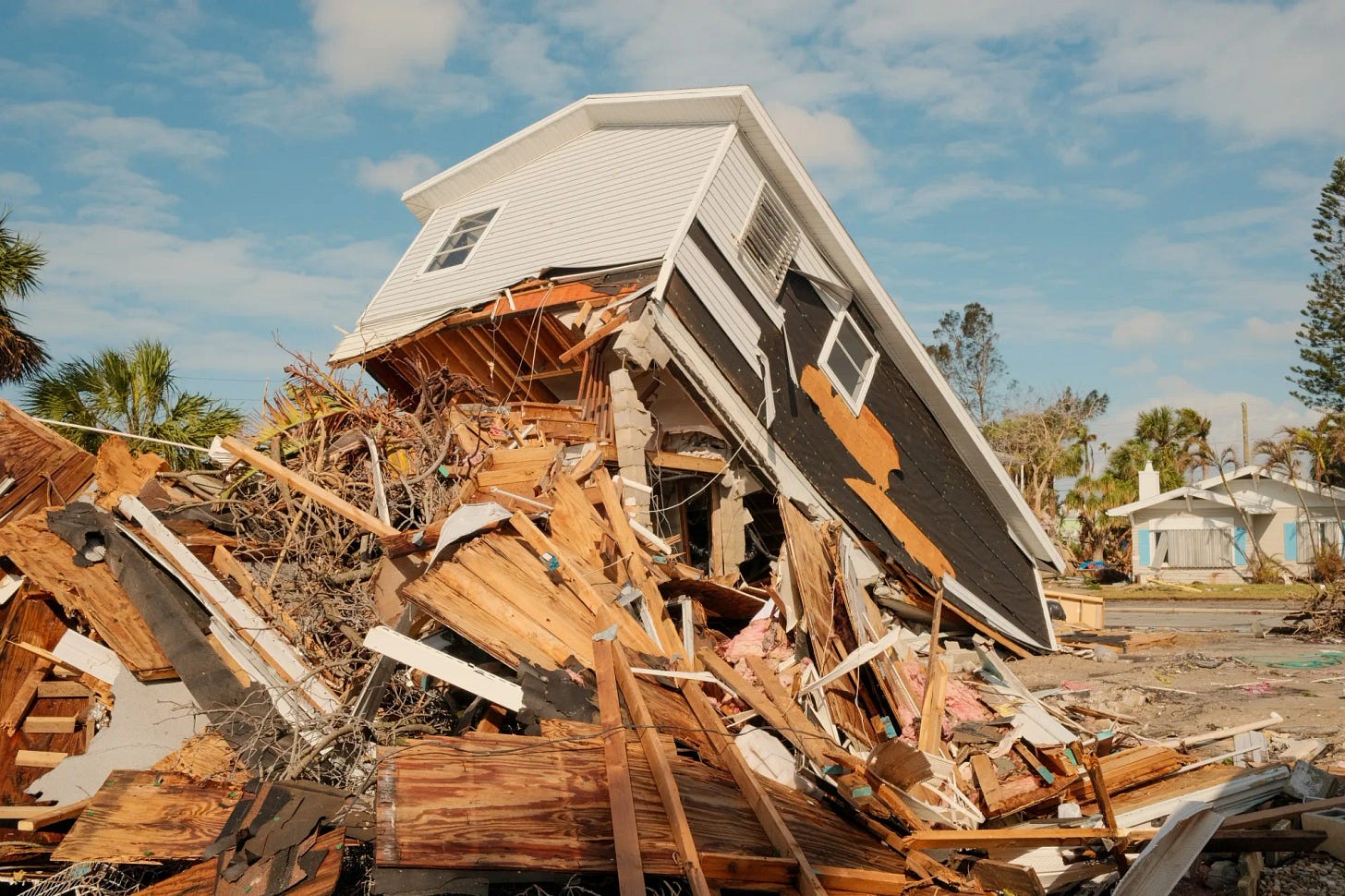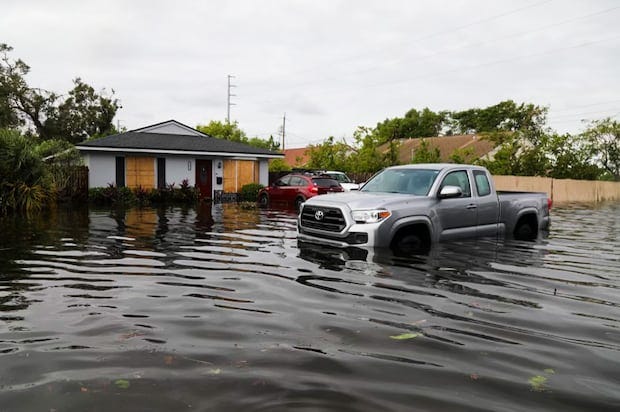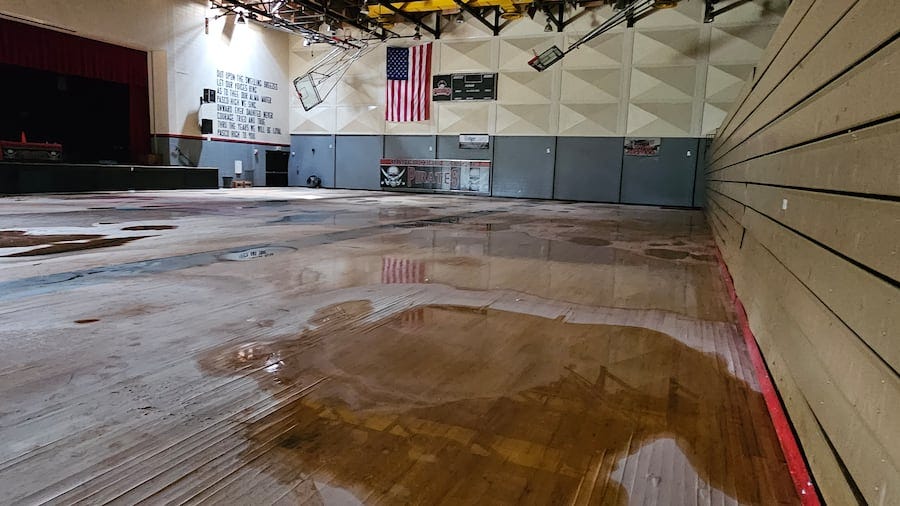Hurricane Milton Recovery Focuses on Power Restoration, Debris Removal, and Aid to Residents
October 17, 2024 — This Week's Top Stories in Florida
Welcome to this week’s edition of Floridian Today, a newsletter about all things Florida — from politics, business, real estate, and climate. Reporting from the Sunshine State, these are the most important stories you need to know. To never miss an update, subscribe here:
Here’s the latest from Florida…
Florida Reels from Hurricane Milton's Devastating Impact
Hurricane Milton's destructive path across Florida has left residents reeling once again, facing a daunting recovery in the wake of Hurricane Milton, which struck Florida's Gulf Coast just 13 days after Hurricane Helene. The Category 3 storm made landfall at Siesta Key on Wednesday evening, unleashing destructive winds, torrential rain, and deadly storm surge across the region. While Tampa Bay narrowly avoided the catastrophic storm surge initially feared, Milton's fury left an unmistakable mark. 3.4 million residents faced power outages, including more than 900,000 statewide outages reported on Saturday night–72 hours after the hurricane made landfall. Many homes and businesses were left destroyed, and a long road to recovery lay ahead. Entire communities were submerged under several feet of floodwater and tornadoes spawned by the power storm destroyed at least 150 homes in central and eastern Florida.
In St. Petersburg, winds exceeding 100 mph toppled a 500-foot crane and shredded the iconic roof of Tropicana Field, home of the Tampa Bay Rays. The storm's relentless march across Central Florida claimed at least 23 lives and coastal communities, still reeling from Helene's impact, now face the overwhelming task of distinguishing damage between the two storms. Record-breaking rainfall inundated inland areas, with parts of Pinellas and Hillsborough counties receiving 17 inches in just six hours. As over 80,000 Floridians had safely sheltered from the storm, the deluge prompted a rare flash flood emergency and led to dramatic rescue operations. In Clearwater, law enforcement evacuated about 540 people from a single apartment complex, and another 135 were rescued from an assisted living facility in Tampa. Amid the devastation, communities have shown resilience with the arduous process of rebuilding just beginning.
Florida Focuses on Recovery, Aid After Hurricane Milton
As Florida grapples with the aftermath of Hurricane Milton, recovery efforts are continuing across the state. Less than 65,000 customers remain without power nearly 7 days after the storm made landfall. Governor Ron DeSantis has repeatedly emphasized state and federal resources are being mobilized to support hard-hit areas, outlining the top priorities: restoring power, clearing debris, assisting victims, and distributing fuel. The National Weather Service reports that St. Petersburg experienced 18.31 inches of rain in 24 hours, including more than 5 inches in a single hour – classifying it as a rare 1-in-1,000-year rainfall event. Flooding remains a significant concern in western and central Florida, where creeks and rivers continue to rise.
Nearly 30% of gas stations across the state reported limited fuel supply for days after Milton passed, making refueling especially difficult for first responders and those reentering Florida following mandatory evacuations. The Tampa and St. Petersburg area was particularly impacted as 78% of stations reported no fuel. To address shortages across the state, free distribution depots have been established in Charlotte, Hillsborough, Pasco, Pinellas, and Sarasota counties, with the Florida Highway Patrol escorting fuel shipments to ensure supply reaches affected areas. Fuel supply is expected to return to normal by Wednesday following the reopening of Port Tampa Bay – responsible for delivering about half the fuel to the state – and SeaPort Manatee on Saturday with storm-related restrictions. Still, challenges remain, with nearly 30% of Florida's gas stations still without fuel.
Over 1,800 people and 225 animals were rescued in the state, and most public school districts reopened this week. All major highways and bridges in the Tampa Bay area reopened within 24 hours, and airports in the region have resumed normal operations, with Sarasota-Bradenton International Airport reopening on Wednesday after enduring $10 million in damage. The Gulf Coast was battered with heavy winds and substantial rainfall that drove serious inland flooding whereas coastal cities south of where the eye of Hurricane Milton made landfall in Siesta Key saw considerable storm surge. Last Friday, President Biden approved a major disaster declaration, enabling federal assistance programs for affected individuals and local governments in 34 counties and the Miccosukee Tribe of Indians of Florida. In addition, to temporary housing and low-cost loan programs, federal funding is approved for nonprofit organizations to assist with emergency work.
In the aftermath of Hurricane Milton, the threat of flooding persists across the state. The National Weather Service has warned of rising water levels in numerous rivers, with major flood stages reported from Tampa Bay to Daytona Beach. Multiple waterways in the Tampa Bay area, including the Anclote, Hillsborough, Manatee, Withlacoochee, and Alafia rivers, have reached major flood stages. The Alafia River crested at a record 24.34 feet on Friday, while the Hillsborough River near Zephyrhills hit its highest level ever at 17.14 feet. Officials in Hillsborough and Pasco counties have issued urgent flood warnings, urging residents in low-lying areas near rivers and lakes to relocate. Over the weekend, the historical flooding resulted in Pasco County first responders conducting boat patrols in flooded neighborhoods to evacuate nearly 100 residents. Water levels continue to rise and authorities warn of dangerous conditions as further evacuations may be necessary.
President Biden Surveys Florida Storm Damage, Announces $612 Million Recovery Fund
President Joe Biden visited storm-ravaged Pinellas County on Sunday, announcing a $612 million investment to support recovery efforts following Hurricanes Milton and Helene. Speaking in front of a damaged home in St. Pete Beach, Biden outlined plans to bolster Florida's resilience against future storms. The U.S. Department of Energy will disperse $94 million to Florida Power & Light and Gainesville Regional Utilities to enhance electric grid resilience. Biden emphasized the importance of reducing power outage frequency and duration in the face of increasingly extreme weather events. Biden met with local business owners and residents and noted the historic number of Floridians - over 250,000 - who applied for FEMA assistance on Saturday alone after the major disaster declaration was made. U.S. Energy Secretary Jennifer Granholm highlighted ongoing projects, including undergrounding power lines and raising flood-prone substations, part of a $2.5 billion infrastructure investment in the Southeast by the federal government and private utilities. Biden reported on FEMA's aid distribution, including 1.2 million meals, 79,000 gallons of water, and 2 million gallons of fuel as local officials expressed gratitude for federal support and determination to rebuild. He also reported that more than 10 FEMA Disaster Recovery Centers have been opened across Florida, and 100 satellite terminals have been installed to restore communication services. The presidential visit included an aerial tour of the damage in Pinellas County and meetings with bipartisan leaders, though notably absent was Governor Ron DeSantis.
DeSantis Announces State-Led Debris Removal Effort
Governor Ron DeSantis announced on Sunday that Florida is mobilizing state resources to assist with debris removal in the aftermath of Hurricanes Milton and Helene. This move comes as FEMA approved a 100% reimbursement rate for debris collection in affected areas for 90 days, a significant increase from the usual 75% federal reimbursement. DeSantis emphasized the importance of swift action, stating, "If you wait, if it takes a year, then you're not gonna get the bang for the buck." To capitalize on this opportunity, the governor has directed over 2,800 personnel from various state agencies, including the Department of Transportation, State Guard, National Guard, and Highway Patrol, to assist in the cleanup efforts. The debris removal mission will primarily focus on Pinellas, Manatee, and Sarasota counties, with additional support for smaller, economically challenged counties. To expedite the process, the state has suspended size and weight requirements for debris removal vehicles. Local governments are being required to identify potential debris removal sites and report daily progress, which will be publicly accessible via an online dashboard. DeSantis and Kevin Guthrie, director of the Florida Division of Emergency Management (FDEM), urged local authorities to submit their cost estimates promptly to take advantage of the expedited reimbursement process. This state-led effort marks an unprecedented approach to post-hurricane cleanup, as debris removal is typically managed by local governments and has taken months or over one year following previous storms like Hurricane Irma in 2017. The effort builds on the state's recent experience with Hurricane Helene, where crews removed about half of the debris on barrier islands within 72 hours.
Fuel Relief in Sight Following Storm
Longlines, limited supply, out-of-order bags on fuel nozzles, and closed gas stations have been a frequent sight in Florida as residents have struggled to fuel up in the aftermath of Hurricane Milton. State officials are optimistic that the gas shortage, impacted by the storm, will be resolved by Wednesday, according to AAA. Conditions are improving rapidly across the state as Florida ports have reopened and all but two gas terminals are operational, allowing tanker trucks to resume 24/7 fuel deliveries. The shortage largely affected the Tampa Bay area, with 20% of gas stations in Hillsborough, Pasco, and Pinellas counties reporting no fuel while others lacked power to operate pumps as of Sunday night. The fuel supply shortage was exacerbated by increased demand from evacuating residents and widespread generator usage. Power outages at gas stations in Milton’s path added to issues as fuel pumps were inoperable. Fuel distribution was further complicated as Port Tampa Bay and SeaPort Manatee were closed to commercial vessels by order of the U.S. Coast Guard, both of which lost electricity and Manatee’s port sustained costly damage. Tampa’s seaport provides 43% of all fuel used in the state, delivered via tanker ships. Until sea operations in Tampa reopened on Saturday afternoon, gasoline was not being delivered and fuel terminals were offline and inaccessible due to floodwaters. As shipping channels reopened and fuel distribution resumed with restrictions, more than 2,500 fuel trucks traveled from the port to deliver fuel to gas stations around Tampa Bay and beyond – carrying about 2 million more gallons from Port Tampa Bay than normal. SeaPort Manatee, even with infrastructure damage, has sent out over 300,000 gallons of gas. The growing population in the affected areas has also strained the fuel supply, especially as the existing fuel distribution infrastructure in the state has remained largely unchanged for over a decade. Additionally, to ease the strain on supply, Gov. DeSantis over the weekend announced the launch of several free-fuel distribution depots in the region to aid residents, offering 10 gallons of gas to refuel vehicles at no charge. The sites, which have opened daily, quickly drew hours-long lines with supplies remaining limited. The State of Florida also deployed 2.4 million gallons from existing reserves for fueling vehicles of emergency personnel.
On Monday, Gov. DeSantis announced an award of $9.5 million to assist recovery efforts at SeaPort Manatee after suffering over $200 million in hurricane-related damages. The funds will be used to ensure fuel is supplied to and delivered from the port and to further boost the economy after the port generated $275 million in state and local revenue in 2023.
Meanwhile, gas prices remain steady from last week, with a gallon of regular unleaded costing an average of $3.10 in the state.
Tampa Bay Neighborhoods Flooded Despite Not Being in Flood Zones
Many residents in Tampa Bay are reeling after neighborhoods that have never flooded were swamped by Hurricane Milton. Heavy rains submerged homes and cars in areas like St. Petersburg's popular Kenwood neighborhood, leaving many shocked. Residents living in non-evacuation zones and areas designated as low flood risk by FEMA were caught off guard as water surged from lakes and retention ponds, affecting homes in Lutz, New Tampa, and Pasco County. The storm's unprecedented rainfall overwhelmed local infrastructure, creating familiar scenes across the region of submerged cars, inundated homes, and even numerous accounts of sewage backing up through drains. As many of these areas were not designated as flood zones, it has raised renewed concerns about obsolete flood maps. Experts warn that rising tides and new construction are worsening flooding risks, which has resulted in the loss of natural flood barriers like wetlands and mangroves which has exacerbated the problem. Outdated drainage systems, overwhelmed by the storm, have left water with nowhere to go. Only 18% of residents carry flood insurance and now face significant out-of-pocket expenses for repairs. As climate change makes extreme weather events more frequent and intense, there will be a renewed push for governments to improve stormwater infrastructure and update building codes. The example of Babcock Ranch, a planned community near Punta Gorda, which weathered Hurricane Ian with minimal damage is a testament to the success of resilient urban planning, including advanced drainage systems and innovative stormwater management. However, retrofitting older neighborhoods will require substantial investment and political will to avoid repeat devastation.
Power Restoration Nears Completion After Hurricane Milton
Nearly a week after Hurricane Milton's devastating impact, Florida utilities are in the final stages of power restoration efforts. The storm initially left over 3.4 million homes and businesses without electricity, but as of Wednesday afternoon, that number has dramatically decreased to below 65,000 statewide. Duke Energy Florida reports completing over 99% of restorations in Pasco County, with efforts continuing in Pinellas County, where approximately 11,000 customers remain without electricity as of late Wednesday afternoon. Many of the remaining outages are due to damaged equipment serving a small number of customers, often located in residential areas with limited access, Duke Energy said. Lineworkers are facing challenges in reaching these malfunctioning devices, as they may need to climb poles instead of using bucket trucks. Customers who had severe damage or flooding may experience extended outages, as repairs and replacements can be more complex. Tampa Electric has made “significant progress,” restoring power to 75% of the nearly 600,000 affected customers in Hillsborough and Pinellas Counties by Monday morning, ahead of schedule. Still, more than 33,000 remain without power in Hillsborough County as of Wednesday afternoon. Florida Power & Light Company (FPL) has restored service to more than 1.9 million customers, focusing on the hardest-hit areas. Outages from Hurricane Milton were largely caused by uprooted trees and other storm debris that knocked down overhead power lines and poles. Flooding of electrical infrastructure and debris on transmission lines further added to electrical infrastructure damage and extended power restoration delays. Utility companies have deployed thousands of workers, including line workers and tree trimmers, working around the clock with shifts as long as 16 hours in many cases. As Florida recovers, the statewide restoration efforts highlight the utilities' improved response capabilities as well as infrastructure hardening and smart-grid investments following recent hurricanes that has reduced outages. Linemen from 43 states have traveled to the state following Hurricane Milton.
Schools Reopen in Wake of Hurricane
As Florida recovers from Hurricane Milton, school districts across the state are working diligently to reopen campuses. Many districts, particularly in the Tampa Bay region, remained closed on Monday as cleanup efforts continue. In Hillsborough County, schools are undergoing extensive cleaning and repairs after reporting external and internal damage, with standing water in classrooms and leaky roofs. Community support has been strong, with parents and students volunteering to help prepare campuses for Thursday’s reopening. As of Monday morning, roughly 100 buildings remained without power, including 35 schools but utilities expected to have power restored when students return. Pinellas County schools resumed classes on Wednesday after five schools endured roof or window damage and many more went days without electricity. Bus routes and cafeteria preparations are also being evaluated to ensure a smooth reopening. Some districts remained closed after stating food deliveries for breakfast and lunch were delayed. Many families are eager to return, but some students and staff face significant post-storm challenges, requiring the school district to work with those unable to return immediately. As schools work towards reopening, most districts have not made decisions have been made regarding makeup days. However, Brevard County schools have confirmed that Thanksgiving break will not be used to compensate for lost time. As most Central Florida school districts like Brevard, Orange, Osceola, Hardee, Hernando, Seminole, and Volusia reopened on Tuesday, others such as Pinellas, Polk, and Sarasota welcomed students back on Wednesday. Hillsborough and Manatee County Public Schools targeted a Thursday reopening for teachers and students. The focus by school officials remains on ensuring safe, functional learning environments for students' return.
Thanks for reading this edition of Floridian Today. To never miss an update, subscribe for free:
In the meantime, if you learned something or found this read interesting, please consider sharing it to grow our community!












